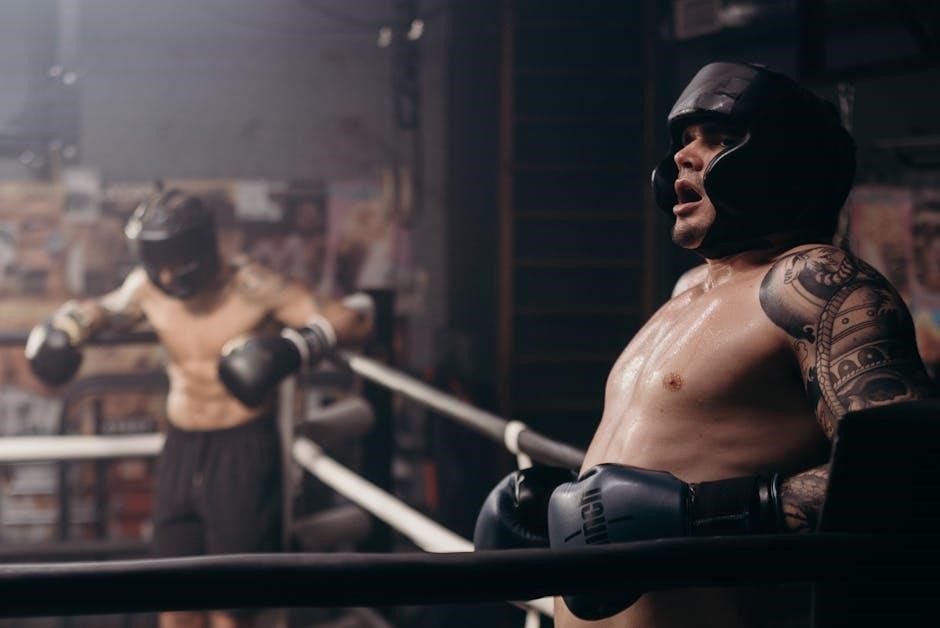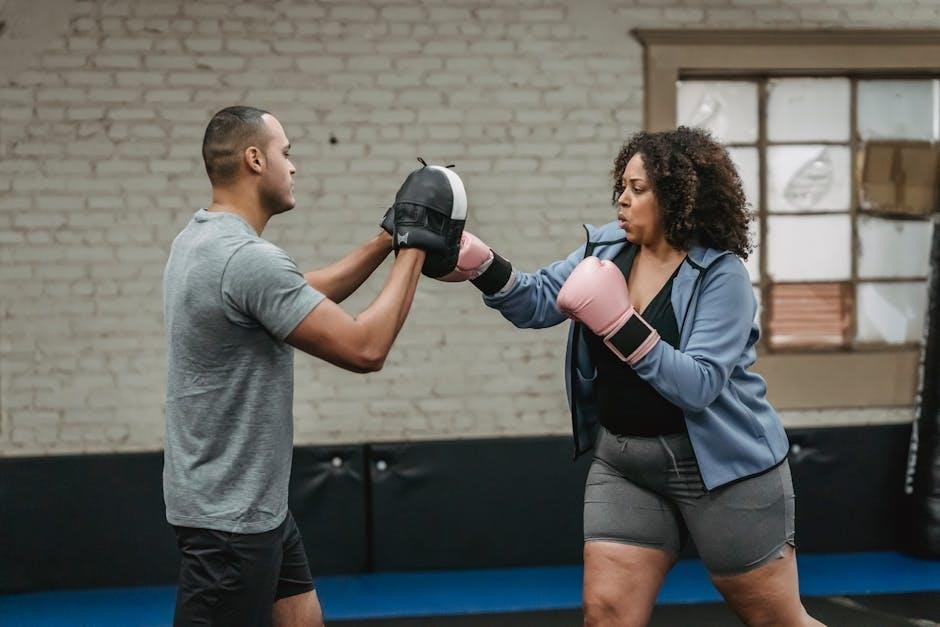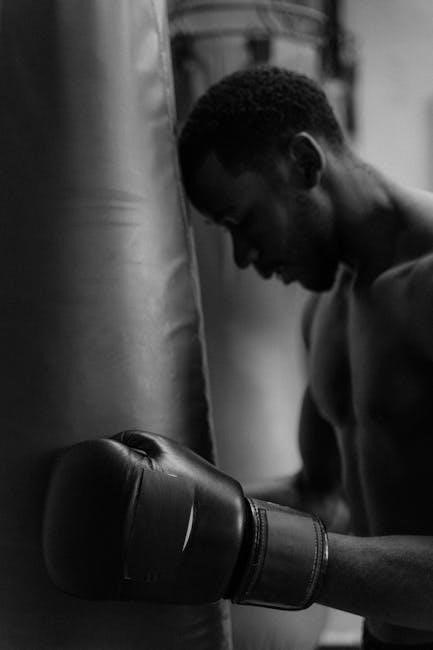
Boxing gloves are essential for protection, performance, and safety, with sizes varying by weight and purpose. Proper fit ensures comfort, reduces injury risk, and enhances training efficiency. Glove weight, padding, and material significantly impact functionality, making size selection crucial for optimal results in training and competition.
Importance of Proper Glove Size
Proper glove size is crucial for optimizing performance, preventing injuries, and ensuring comfort during training. Ill-fitting gloves can hinder technique and overall progress, emphasizing the need for a precise fit.
2.1 Why Glove Size Matters
The correct glove size is essential for both protection and performance. Properly fitting gloves ensure adequate padding for the hands, reducing the risk of injuries during training or competition. A well-sized glove supports the hand’s natural structure, allowing for effective striking and minimizing the impact on wrists and fingers. Incorrect sizing can lead to discomfort, poor technique, and increased risk of sprains or fractures. Additionally, gloves that are too tight may restrict movement, while oversized gloves can hinder control and precision. Choosing the right size ensures optimal comfort, safety, and performance, making it a critical factor in a boxer’s success. Proper fit is non-negotiable for peak performance and long-term hand health.
2.2 Impact on Performance and Safety
Properly sized boxing gloves significantly influence both performance and safety. Ill-fitting gloves can hinder technique, reduce punching power, and cause fatigue. Gloves that are too small may lead to inadequate padding, increasing the risk of hand injuries, such as fractures or sprains. Conversely, gloves that are too large can impede control and precision, affecting accuracy during training or competition. Safety is compromised when gloves fail to provide sufficient cushioning, exposing hands and wrists to excessive impact. Ensure the right fit to maintain optimal performance, protect against injuries, and enhance overall training effectiveness. The balance between comfort and support is vital for peak performance and long-term hand health.
Understanding Glove Weight Classes
Boxing gloves are categorized by weight, ranging from 8 to 18 ounces. Each weight serves specific purposes, such as training, sparring, or competitions. Understanding these classes ensures proper selection for optimal performance and safety.
3.1 8-10 oz Gloves: Uses and Benefits
8-10 oz boxing gloves are ideal for competitive fights and advanced training. They provide a balance between speed and protection, making them suitable for skilled boxers. The lighter weight enhances punch speed and precision, while the padding ensures adequate hand protection. These gloves are often used in bag work and pad training to improve technique and power. They are also preferred by professional fighters during matches due to their responsiveness. However, they may lack the cushioning needed for heavy sparring, making them less ideal for prolonged impact training. Overall, 8-10 oz gloves are perfect for refining skills and performance in competitive settings.
3.2 12 oz Gloves: Ideal for Training
12 oz boxing gloves are widely regarded as the standard for training, offering exceptional cushioning and protection. They are ideal for sparring, bag work, and pad training, providing ample padding to absorb impact while minimizing hand fatigue. These gloves are particularly suited for intermediate to advanced boxers, as they strike a balance between comfort and responsiveness. The extra weight and padding make them perfect for prolonged training sessions, reducing the risk of injury to both the hands and the training partner. Many boxers prefer 12 oz gloves for their versatility, as they can be used for a variety of drills, from technical work to high-intensity sparring. Their durability and support make them a popular choice for consistent training routines.
3.3 14 oz Gloves: Versatility in Training
14 oz boxing gloves are a versatile option for training, offering a blend of cushioning and responsiveness. They are heavier than 12 oz gloves, providing additional padding for added protection during intense workouts. These gloves are ideal for sparring, bag work, and pad training, making them a favorite among boxers who need a balanced combination of comfort and performance; The extra weight helps absorb impact, reducing strain on the hands and wrists. They are also suitable for boxers with larger hands, as the added material provides a snug and secure fit. Their versatility makes them a popular choice for intermediate to advanced boxers seeking durability and comfort in various training scenarios.
3.4 16 oz Gloves: Standard for Sparring
16 oz boxing gloves are widely regarded as the standard for sparring due to their exceptional safety features and comfort. Designed to provide ample padding, these gloves minimize the impact on both the wearer’s hands and their opponent’s face. The added weight and cushioning make them ideal for prolonged training sessions, ensuring reduced risk of injury. They are recommended for intermediate to advanced boxers, offering a balance between protection and responsiveness. The 16 oz gloves are also durable, withstanding the rigors of frequent use. Their popularity stems from their ability to protect hands while allowing for effective striking technique during sparring sessions. This makes them a staple in many boxing gyms worldwide.
3.5 18 oz Gloves: Heavyweight Training
18 oz boxing gloves are designed for heavyweight training, offering maximum padding and protection. They are ideal for intense strength and conditioning workouts, as well as for boxers who prefer a heavier glove for building stamina. These gloves provide additional cushioning, reducing hand fatigue and absorbing impact effectively. They are often used by heavier boxers or those with larger hands, ensuring a comfortable fit. The 18 oz gloves are also popular in professional training camps, where durability and safety are paramount. While they may feel bulky, they allow for powerful strikes without compromising on protection. This makes them a favorite for serious athletes focused on strength and endurance training.

Training Purpose and Glove Size
The training purpose directly influences glove size, ensuring proper hand protection and impact absorption. Different glove sizes suit sparring, bag work, or competitions. Match your glove size to your training focus for optimal performance and safety.
4.1 Bag Work and Pad Training
Bag work and pad training require gloves that balance protection and dexterity. Lighter gloves (8-12 oz) are ideal for these drills, allowing for faster hand speed and precision. Proper fit ensures minimal hand fatigue while maintaining proper technique. The padding should adequately cushion impacts without restricting movement. Snug yet comfortable gloves help prevent injuries during repetitive striking. For pad work, a secure fit is crucial to maintain control and responsiveness. Hand wraps worn underneath add extra support. Choosing the right size enhances performance and reduces the risk of injury during high-intensity training sessions. This ensures optimal protection and mobility for effective skill development.
4.2 Sparring: Safety and Comfort
Sparring demands gloves that prioritize safety and comfort to protect both you and your partner. Heavier gloves (16 oz) are typically used for sparring to provide extra cushioning and reduce impact force. Proper fit is essential to prevent injuries and ensure comfort during prolonged sessions. Gloves that are too tight can restrict movement, while overly loose ones may fail to provide adequate support. The padding and material quality play a significant role in absorbing shock and distributing force evenly. A well-fitted glove enhances safety, allowing for a more enjoyable and injury-free sparring experience. Choosing the right size ensures optimal protection and comfort for both participants during live drills.
4.3 Competitions: Regulations and Requirements
In competitive boxing, glove size is strictly regulated to ensure fairness and safety. Amateur and professional competitions typically require specific weights, with 10 oz gloves being standard for professional bouts and 12 oz for amateur matches. The size may vary based on the boxer’s weight class, with lighter boxers using smaller gloves. Sanctioning bodies like the IOC or WBC enforce these rules to maintain uniformity. Gloves must meet safety standards, including approved materials and padding. Failure to comply can result in penalties or disqualification. Always verify the specific regulations for your event to ensure compliance and avoid issues during competition.

Materials Affecting Glove Size
Materials significantly impact glove size, with leather offering durability and a snug fit, while synthetic options provide flexibility and varied weight distribution for different training needs.
5.1 Leather vs. Synthetic Materials
Leather and synthetic materials differ significantly in terms of durability, comfort, and fit. Leather gloves are typically more durable and provide a snug, moldable fit over time, making them a favorite among professional boxers. Synthetic materials, such as vinyl or PU, are more affordable and easier to maintain, offering a consistent fit and better hygiene. Leather tends to be heavier, which can affect weight distribution, while synthetic gloves may feel lighter but less form-fitting. The choice between the two often depends on personal preference, training intensity, and budget. Both materials are available in various sizes, but leather gloves may require a slightly larger size for optimal comfort.
5.2 Padding and Foam Types
Padding and foam types play a crucial role in determining the comfort, protection, and overall performance of boxing gloves. High-quality foam padding ensures better shock absorption, reducing the impact on both the hands and the opponent. Single-layer foam is lightweight and ideal for speed, while multi-layer foam offers superior cushioning and durability. Gel-infused padding provides excellent energy absorption, making it suitable for heavy hitters. The density and thickness of the foam also affect the glove’s weight distribution and fit. Proper padding ensures a snug fit, preventing excessive movement that could lead to injury. The choice of foam type depends on training intensity, fighting style, and personal comfort preferences, ensuring optimal protection and performance.

Boxing Glove Size Charts
Boxing glove size charts categorize gloves by weight classes and hand circumference, ensuring proper fit and protection. They guide boxers in selecting the ideal size for their needs.
6.1 Adult Size Chart
Adult boxing glove size charts typically range from 8 to 18 ounces, catering to different hand sizes and training purposes. Glove weight corresponds to cushioning and protection levels, with lighter gloves (8-12 oz) suited for bag work, pad training, or competitions, while heavier gloves (14-18 oz) are ideal for sparring and heavy training. Hand circumference is measured around the knuckles and palm to determine the appropriate size. Charts often include small, medium, large, and extra-large options, ensuring a snug yet comfortable fit. Proper sizing prevents hand fatigue and injury, making it essential to refer to a reliable size chart before purchasing. Always consider both weight class and hand measurement for the best fit.
6.2 Youth Size Chart
Youth boxing gloves are designed for younger athletes, typically aged 6 to 14, with smaller hand sizes. These gloves range from 8 to 12 ounces, providing adequate protection without being overly bulky. Size charts for youth gloves often categorize hand sizes as small, medium, or large, based on circumference measurements. Proper fit is crucial to ensure safety and performance. Parents or coaches should measure the young boxer’s hand circumference around the knuckles and palm to select the correct size. Hand wraps are also considered when fitting, as they add bulk. Youth size charts are tailored to accommodate smaller hands, ensuring comfort and support during training or competition. Always refer to a reliable chart to avoid oversized or undersized gloves.

Measuring Hand Circumference
Measuring hand circumference is a critical step in determining the correct boxing glove size. To measure accurately, wrap a flexible tape measure around the widest part of your hand, just above the knuckles, with your fingers together and your hand in a closed fist. Ensure the tape is snug but not tight. The average circumference for adults ranges from 7 to 10 inches, while youth measurements are slightly smaller. This measurement, combined with glove weight classes, helps ensure a proper fit. Always measure both hands, as they may differ slightly. Accurate hand circumference ensures optimal comfort, protection, and performance. Use this measurement alongside size charts for the best results. Proper sizing is essential for safety and effectiveness in training or competition.

Fitting with Hand Wraps
Fitting boxing gloves with hand wraps is essential for optimal performance and protection. Hand wraps add bulk to the hands, so gloves must accommodate this extra material. When choosing gloves, consider the thickness of your hand wraps, as they can affect the overall fit. Thicker wraps may require a slightly larger glove size, while thinner wraps allow for a snugger fit. Always try on gloves with your preferred hand wraps to ensure proper sizing. The combination of wraps and gloves should feel comfortable and supportive, allowing for full range of motion while protecting the hands during training or sparring. Proper fit ensures safety and performance. Hand wraps and gloves work together to provide the best results.

Amateur vs. Professional Gloves
Amateur and professional boxing gloves differ in design, safety features, and regulations. Amateur gloves are designed for competitions and must meet specific standards, often featuring more padding for added protection. They typically have a wider cuff and a secure thumb lock to prevent eye injuries. Professional gloves, used in actual fights, are lighter and more streamlined, allowing for greater impact. They are made from premium materials like leather for durability and performance. Amateur gloves are also easier to clean and maintain, as they are used in training and shared among athletes. Professional gloves prioritize fit, feel, and punch precision. The choice between amateur and professional gloves depends on the athlete’s level, training purpose, and competition requirements. Understanding these differences is crucial for selecting the right pair. Proper gloves enhance safety and performance in both amateur and professional settings. They are tailored to meet specific needs, ensuring optimal results.

Special Considerations
Consider hand size, finger length, and closure type for optimal fit. Customization options and break-in periods may enhance performance and comfort during training.
10.1 Long Finger Athletes
For athletes with exceptionally long fingers, finding the right boxing glove size is crucial. Standard gloves may not provide adequate finger length, leading to discomfort or restricted movement. Proper fit ensures fingers are not compressed, allowing for natural dexterity and punch mechanics. Long-fingered athletes should prioritize gloves with extended finger compartments or consider custom options. Testing the fit by wearing hand wraps and trying on gloves is essential. Materials like leather or high-quality synthetics offer better structure and support. Improper fit can result in limited performance and increased risk of injury. Selecting gloves designed for longer fingers ensures safety, comfort, and optimal performance during training or competition.

Common Mistakes to Avoid
When selecting boxing gloves, avoid common mistakes that compromise fit, performance, and safety. Many boxers choose gloves that are too small, believing they offer more support, but tight gloves restrict hand movement and comfort. Neglecting to measure hand circumference accurately leads to poor fit and reduced performance. Another mistake is not considering the glove’s intended use, such as training or sparring, which require different sizes. Additionally, some athletes overlook the importance of trying gloves with hand wraps, as wraps add bulk and affect fit. Ignoring these factors can result in discomfort, reduced dexterity, and increased risk of injury. Always prioritize proper sizing and purpose-specific gloves for optimal results.

Maintenance and Care
Proper maintenance and care extend the lifespan of boxing gloves, ensuring they remain hygienic and functional. After use, clean the exterior with a damp cloth and mild soap to remove sweat and dirt. Allow gloves to air-dry completely to prevent mold and odors. Store them in a cool, dry place, away from direct sunlight. Avoid using harsh chemicals or soaking the gloves, as this can damage materials. Regularly inspect for wear and tear, such as loose stitching or flattened padding, and replace them when necessary. Proper care not only maintains performance but also ensures hygiene and safety during training or competition.